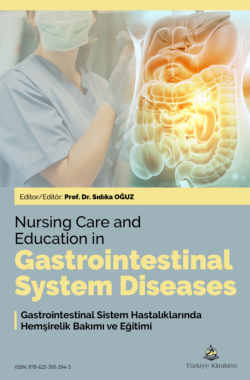Nursing Care and Education in Esophageal Diseases
Gülşah ÇAMCIa
aMarmara University Faculty of Health Sciences, Department of Nursing, Division of Internal Medicine Nursing, İstanbul, Türkiye
Çamcı G. Nursing care and education in esophageal diseases. In: Oğuz S, ed. Nursing Care and Education in Gastrointestinal System Diseases. 1st ed. Ankara: Türkiye Klinikleri; 2024. p.10-7.
ABSTRACT
Esophageal diseases comprise achalasia, diffuse spasm hiatal hernia, diverticulum, perforation, foreign body, chemical burns, gastroesophageal reflux disease, benign tumor and carcinoma. Among these, the most prevalent disease is gastroesophageal reflux disease. The main approach in treatment is lifestyle modification and pharmacologic treatment. Antacids, proton pump inhibitors and H2-receptor blockers are employed in pharmacologic treatment. Lifestyle modifications are significant to reduce the symptoms and long-term effects of the disease. These changes include lifting the head of the bed, weight loss, stress reduction, breathing exercises, avoiding alcohol, tobacco, caffeine, chocolate, spicy foods, acidic foods and greasy foods. Nurses should provide lifestyle education to patients and their families. In addition, they should provide patients with interventions related to the nursing diagnoses of pain, deterioration in comfort, burden of stress, lack of information, deterioration in sleep pattern, difficulty swallowing, risk of aspiration, inadequacy in nutrition and ineffectiveness in maintaining health.
Keywords: Achalasia diverticulum; gastroesophageal reflux; esophageal diseases; nursing
Kaynak Göster
Referanslar
- Deegan J. Management of patients with oral and oesophageal disorders. In: Farrell M, ed. Smeltzer and Bare's textbook of medical-surgical nursing. 4th ed: Lippincott, Williams and Wilkins; 2017. p. 957-70.
- Hinkle JL, Cheever KH, Overbaugh K. Brunner & Suddarth's Textbook of Medical-Surgical Nursing 15th ed: LWW; 2021.
- Honan L. Focus on adult health: medical-surgical nursing: Lippincott Williams & Wilkins; 2019.
- Jia X, Chen S, Zhuang Q, Tan N, Zhang M, Cui Y, et al. Achalasia: The Current Clinical Dilemma and Possible Pathogenesis. J Neurogastroenterol Motil. 2023;29(2):145-55. [Crossref] [PubMed] [PMC]
- Özbayır T, Çınar Akyüz S. Ağız ve Üst gasrtointestinal sistem hastalıkları. Eti Aslan F, Karadakovan A, editörler. Dahili ve Cerrahi Hastalıklarda Bakım Cilt 1. 5. baskı. Ankara: Akademisyem Kitabevi; 2020. p. 657-74.
- Ribolsi M, Andrisani G, Di Matteo FM, Cicala M. Achalasia, from diagnosis to treatment. Expert Rev Gastroenterol Hepatol. 2023;17(1):21-30. [Crossref] [PubMed]
- Yam J, Baldwin D, Ahmad SA. Esophageal Diverticula: StatPearls Publishing, Treasure Island (FL); 2022 2022.
- Kamboj AK, Law RJ. Management of Esophageal Diverticula. Current Treatment Options in Gastroenterology. 2023;21(1):15-26. [Crossref]
- Akdemir N, Tosun N. Ağız, Özefagus ve Mide Hastalıkları ve Hemşirelik Bakımı. Akdemir N, editör. İç Hastalıkları ve Hemşirelik Bakımı. 6. baskı. Ankara: Akademisyen Kitabevi; 2020. p. 811-9. [Crossref]
- Yıldırım Keskin A. Gastroözefajiyal Reflü Hastalığı Ve Bakım Yönetimi. In: Özer S, editor. Olgu Senaryolarıyla Iç Hastalıkları Hemşireliği: İstanbul: İstanbul Tıp Kitabevleri; 2019. p. 399-417.
- Chen J, Brady P. Gastroesophageal Reflux Disease: Pathophysiology, Diagnosis, and Treatment. Gastroenterology Nursing. 2019;42(1):20-8. [Crossref] [PubMed]
- Gyawali CP, Fass R. Management of Gastroesophageal Reflux Disease. Gastroenterology. 2018;154(2):302-18. [Crossref] [PubMed]
- Antunes C, Aleem A, Curtis S. Gastroesophageal Reflux Disease: StatPearls Publishing LLC; 2022. p.1-8.
- Smith W, Davila N. Gastroesophageal reflux disease: 2021 guideline updates and clinical pearls. The Nurse Practitioner. 2023;48(7):24-5. [Crossref] [PubMed]
- Maret-Ouda J, Markar SR, Lagergren J. Gastroesophageal Reflux Disease: A Review. JAMA. 2020;324(24):2536-47. [Crossref]
- Tran CL, Han M, Kim B, Park EY, Kim YI, Oh JK. Gastroesophageal reflux disease and risk of cancer: Findings from the Korean National Health Screening Cohort. Cancer Med. 2023;12(18):19163-73. [Crossref] [PubMed] [PMC]
- Liu Z, Gao X, Liang L, Zhou X, Han X, Yang T, et al. Prevalence, General and Periodontal Risk Factors of Gastroesophageal Reflux Disease in China. Journal of Inflammation Research. 2023;16:235-44. [Crossref] [PubMed] [PMC]
- Lemone P, Burke K, Dwyer T, Levett-Jones T, Moxham L, Reid-Searl K. Medical-Surgical Nursing Critical Thinking for Person-centred Care. third edition ed: Pearson Higher Education AU; 2017.
- Zdrhova L, Bitnar P, Balihar K, Kolar P, Madle K, Martinek M, et al. Breathing Exercises in Gastroesophageal Reflux Disease: A Systematic Review. Dysphagia. 2023;38(2):609-21. [Crossref] [PubMed] [PMC]
- Ribolsi M, Giordano A, Guarino MPL, Tullio A, Cicala M. New classifications of gastroesophageal reflux disease: an improvement for patient management? Expert Review of Gastroenterology & Hepatology. 2019;13(8):761-9. [Crossref] [PubMed]
- Smeltzer SC, Bare BG, Hinkle JL, Cheever KH. Brunner & Suddarth's Textbook of Medical-Surgical Nursing: Lippincott Williams & Wilkins; 2009.
- Erdemir F, Türk G. Hemşirelik tanıları el kitabı. İstanbul: Nobel Tıp kitabevi; 2021.
- Polat Dünya C, Tülek Z. Yutma Güçlüğü. Oğuz S, Ünver V, Çamcı G, Kocatepe V, editörler. Semptom Yönetimi ve Hemşirelik. 1. baskı. İstanbul: İstanbul Tıp Kitabevleri; 2023. p.514-29.
- Erol Ö. İştahsızlık. Oğuz S, Ünver V, Çamcı G, Vildan K, editörler. Semptom yönetmi ve hemşirelik. İstanbul: İstanbul Tıp kitabevleri; 2023. p.233-44.
- Yıldırım D, Kocatepe V. Uykusuzkuk. Oğuz S, Ünver V, Çamcı G, Kocatepe V, editörler. Semptom Yönetimi ve Hemşirelik. İstanbul: İstanbul Tıp Kitabevleri; 2023. p.492.

